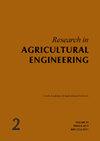玉米芯在不同温度下热解生产生物炭:近似、终极和光谱表征
Q3 Agricultural and Biological Sciences
引用次数: 3
摘要
采用废物变财富方法的概念,玉米棒产生的农业废物可以通过处理生物质的热化学方法转化为可再生能源。这种方法可用于生物炭生产。生物炭的利用有几个重要的应用。这些应用包括通过改良来增强土壤,通过在土壤中输入各种营养物质来刺激作物生产等。在这项研究工作中,通过玉米棒废料的缓慢热解过程获得了生物炭。该实验使用小型马弗炉进行,并在不同温度(300400500°C)下对原料进行加热。制备生物炭,并通过近似分析、扫描电子显微镜(SEM)、傅立叶变换红外光谱(FTIR)对其进行表征,同时通过Saer方法测定表面积。研究了温度对生物炭产率的影响。结果表明,在300、400和500°C温度下,玉米芯生物炭的产量随着温度的升高而降低。理化性能测试结果表明,温度对生物炭的理化性能有很大影响。在300°C下生产的生物炭的固定碳含量最高,为60.5%。在500°C下,最大表面积为(281.8 m2·g–1)。本文章由计算机程序翻译,如有差异,请以英文原文为准。
Pyrolysis of maize cob at different temperatures for biochar production: Proximate, ultimate and spectroscopic characterization
Adopting the concept of the waste to wealth approach, agricultural waste from maize cob could be transformed into a renewable form of energy through thermo-chemical methods of treating the biomass. This method can be utilised for biochar production. The utilisation of biochar has several significant applications. These applications include the enhancement of the soil through amendment, stimulation of crop production by a variety nutrient inputs in the soil, etc. In this research work, a biochar was obtained through a slow pyrolysis process of maize cob waste. This experiment was carried out using a small-scale muffle furnace and subjecting the feedstock to heating at different temperatures (300, 400, 500 °C). The biochar was produced and characterised by a proximate analysis, scan electron microscope (SEM), Fourier transform infrared (FTIR) spectroscopy, while the surface area was determined by Saer's method. The effect of the temperature on the yield of the biochar was investigated. The results show that the biochar yield decreases with an increasing temperature for the maize cob biochar at 300, 400 and 500 °C. The results of the physiochemical properties showed that the temperature has a great impact on the physicochemical properties of the biochar. The biochar produced at 300 °C has the highest fixed carbon content of 60.5%. The largest surface area was (281.8 m2·g–1) at 500 °C.
求助全文
通过发布文献求助,成功后即可免费获取论文全文。
去求助
来源期刊

Research in Agricultural Engineering
Engineering, agriculture-
CiteScore
1.40
自引率
0.00%
发文量
21
审稿时长
24 weeks
期刊介绍:
Original scientific papers, short communications, information, and studies covering all areas of agricultural engineering, agricultural technology, processing of agricultural products, countryside buildings and related problems from ecology, energetics, economy, ergonomy and applied physics and chemistry. Papers are published in English.
 求助内容:
求助内容: 应助结果提醒方式:
应助结果提醒方式:


